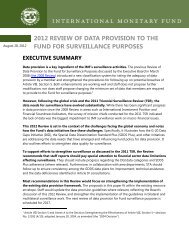ECB Annual Report on supervisory activities
ssmar2016.en.pdf?utm_source=POLITICO.EU&utm_campaign=b1bb431652-EMAIL_CAMPAIGN_2017_03_23&utm_medium=email&utm_term=0_10959edeb5-b1bb431652-189797857&utm_source=POLITICO
ssmar2016.en.pdf?utm_source=POLITICO.EU&utm_campaign=b1bb431652-EMAIL_CAMPAIGN_2017_03_23&utm_medium=email&utm_term=0_10959edeb5-b1bb431652-189797857&utm_source=POLITICO
You also want an ePaper? Increase the reach of your titles
YUMPU automatically turns print PDFs into web optimized ePapers that Google loves.
The quantitative impact of the adverse stress test scenario is <strong>on</strong>e factor in<br />
determining the level of Pillar 2 guidance (P2G). The qualitative outcome of the<br />
stress tests is included in the determinati<strong>on</strong> of the Pillar 2 requirement (P2R) 3 .<br />
Moreover, in additi<strong>on</strong> to risks already identified through the <strong>on</strong>going <strong>supervisory</strong><br />
assessment, the stress test pointed to key vulnerabilities of euro area banks in the<br />
event of an adverse shock. For instance, most loan losses came from unsecured<br />
retail and corporate exposures. The stress test also identified lending to certain<br />
geographies such as Latin America as well as Central and Eastern Europe as a<br />
driver of credit losses.<br />
The SSM <strong>supervisory</strong> priorities set out focus areas for supervisi<strong>on</strong> in a given year.<br />
They build <strong>on</strong> an assessment of the key risks faced by supervised banks, taking into<br />
account the latest developments in the ec<strong>on</strong>omic, regulatory and <strong>supervisory</strong><br />
envir<strong>on</strong>ment. The priorities, which are reviewed <strong>on</strong> an annual basis, are an essential<br />
tool for coordinating <strong>supervisory</strong> acti<strong>on</strong>s across banks in an appropriately<br />
harm<strong>on</strong>ised, proporti<strong>on</strong>ate and efficient way, thereby c<strong>on</strong>tributing to a level playing<br />
field and a str<strong>on</strong>ger <strong>supervisory</strong> impact (see Figure 1).<br />
1.1.2 General performance of significant banks in 2016<br />
Profits of significant instituti<strong>on</strong>s in<br />
the euro area remained stable<br />
5.8%<br />
Return <strong>on</strong> equity in 2016<br />
The results of the first three quarters of 2016 show that the profitability of significant<br />
instituti<strong>on</strong>s remained stable in 2016 4 . The average annualised return <strong>on</strong> equity for a<br />
representative sample of 101 significant instituti<strong>on</strong>s stood at 5.8% in the third quarter<br />
of 2016, slightly decreasing year <strong>on</strong> year (6.0% in the third quarter of 2015) 5 .<br />
However, it should be noted that, behind these aggregate figures, we observe a<br />
great variety of developments.<br />
Recurring revenues c<strong>on</strong>tracted in 2016: the aggregate net interest income of<br />
significant instituti<strong>on</strong>s decreased by 3%, despite a slight increase in loans (+0.5%<br />
year <strong>on</strong> year), particularly in corporate loan volumes (+2.8%). The decrease was<br />
c<strong>on</strong>centrated in the first quarter of 2016. Thereafter, interest revenues stabilised. Fee<br />
income also decreased (-2.8% year <strong>on</strong> year), largely reflecting a decline in<br />
commissi<strong>on</strong>s from asset management and capital markets <strong>activities</strong> during the first<br />
three quarters of 2016. The trend may have been reversed in the fourth quarter of<br />
2016 as capital markets <strong>activities</strong> picked up again.<br />
3<br />
4<br />
5<br />
See also Secti<strong>on</strong> 1.2.1.<br />
In this secti<strong>on</strong>, data for 2016 refer to the third quarter of 2016.<br />
Aggregate return <strong>on</strong> equity stood at 4.8% in the fourth quarter of 2015. On an annualised basis, fourthquarter<br />
figures tend to be lower than third-quarter figures owing to seas<strong>on</strong>ality in some of the<br />
underlying items.<br />
<str<strong>on</strong>g>ECB</str<strong>on</strong>g> <str<strong>on</strong>g>Annual</str<strong>on</strong>g> <str<strong>on</strong>g>Report</str<strong>on</strong>g> <strong>on</strong> <strong>supervisory</strong> <strong>activities</strong> 2016 − Supervisory c<strong>on</strong>tributi<strong>on</strong> to financial<br />
stability 12



